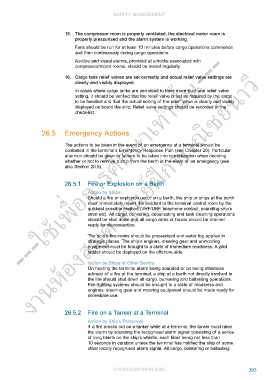Page 427 - International safety guide for oil tankers and terminals
P. 427
SAFETY MANAGEMENT
15. The compressor room is properly ventilated, the electrical motor room is
properly pressurised and the alarm system is working.
---ใช้เพื่อการศึกษาเท่านั้น---
Fans should be run for at least 10 minutes before cargo operations commence
and then continuously during cargo operations.
งานห้องสมุด ศูนย์ฝกพาณิชย์นาวี
Audible and visual alarms, provided at airlocks associated with
compressor/motor rooms, should be tested regularly.
16. Cargo tank relief valves are set correctly and actual relief valve settings are
clearly and visibly displayed.
In cases where cargo tanks are permitted to have more than one relief valve
setting, it should be verified that the relief valve is set as required by the cargo
to be handled and that the actual setting of the relief valve is clearly and visibly
displayed on board the ship. Relief valve settings should be recorded in the
check-list.
26.5 Emergency Actions
The actions to be taken in the event of an emergency at a terminal should be
contained in the terminal’s Emergency Response Plan (see Chapter 20). Particular
attention should be given to factors to be taken into consideration when deciding
whether or not to remove a ship from the berth in the event of an emergency (see
ึ
also Section 20.5).
26.5.1 Fire or Explosion on a Berth
Action by Ships:
Should a fire or explosion occur on a berth, the ship or ships at the berth
must immediately report the incident to the terminal control room by the
quickest possible method (VHF/UHF, telephone contact, sounding ship’s
siren etc). All cargo, bunkering, deballasting and tank cleaning operations
should be shut down and all cargo arms or hoses should be drained
ready for disconnection.
The ship’s fire-mains should be pressurised and water fog applied in
strategic places. The ship’s engines, steering gear and unmooring
equipment must be brought to a state of immediate readiness. A pilot
ladder should be deployed on the offshore side.
Action by Ships at Other Berths:
On hearing the terminal alarm being sounded or on being otherwise
advised of a fire at the terminal, a ship at a berth not directly involved in
the fire should shut down all cargo, bunkering and ballasting operations.
Fire-fighting systems should be brought to a state of readiness and
engines, steering gear and mooring equipment should be made ready for
immediate use.
26.5.2 Fire on a Tanker at a Terminal
Action by Ship’s Personnel:
If a fire breaks out on a tanker while at a terminal, the tanker must raise
the alarm by sounding the recognised alarm signal consisting of a series
of long blasts on the ship’s whistle, each blast being not less than
10 seconds in duration unless the terminal has notified the ship of some
other locally recognised alarm signal. All cargo, bunkering or ballasting
© ICS/OCIMF/IAPH 2006 393

